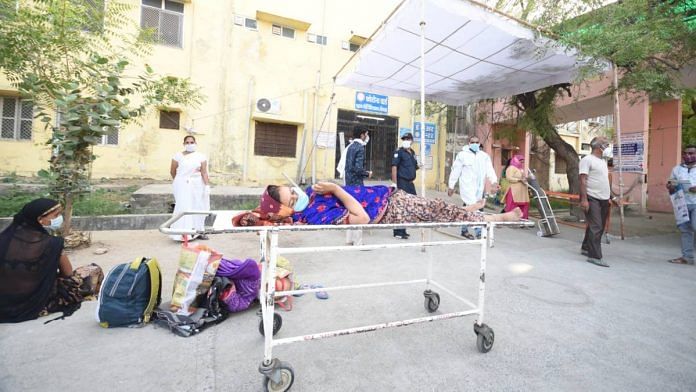Bhilwara: Mahatma Gandhi (MG) District Hospital, the only key government facility for Covid treatment in Rajasthan’s Bhilwara district, is reeling under the steady flow of patients in the second wave of the pandemic. Every two-three minutes, an ambulance enters, carrying fresh patients. Many of the afflicted lie outside on stretchers, as they wait for a bed to be vacated and assigned to them. Family members of patients plead with doctors to treat them, repeatedly ask how much longer they would have to wait.
Near the entrance to the Covid ward, Laxmi Ujjain, whose husband, Ram Lal — a Covid patient — is in desperate need of a bed with oxygen support, approached ThePrint journalist with folded hands. “Mera pati mar jayega, didi, main 4 ghante se wait kar rahi hoon [My husband will die. I have been waiting for four hours],” she pleads, hoping this reporter will be able to help her husband’s cause.
Close by, Hari Mathur is gasping for breath, as he waits in an ambulance. One of his relatives looks out of the ambulance window, desperately seeking help and motions to a nurse approaching them, to hurry.
The current situation here is in stark contrast to conditions last year, when the Covid pandemic first hit the country. At the time, Bhilwara, known as the textile city of India, had earned accolades for its brilliant management of the pandemic. The ‘Bhilwara model of Covid management’ had also drawn appreciation from Prime Minister Narendra Modi. Back then the district had been the first in the country to stop new infections within a span of two weeks.
Controlling the second wave has, however, proven to be more challenging.
From reporting two new cases on 28 February, to 535 new cases on 28 April, there has been a big surge in the past two months, taking the district’s positivity rate to 30.68 per cent.
According to government data, Bhilwara was reporting between 20-30 new cases daily around the end of March. But the number went up exponentially in April. On 26 April, the district reported 701 new Covid cases, among the highest in the border districts of Rajasthan. The Covid casualty has ranged between two or three per day.
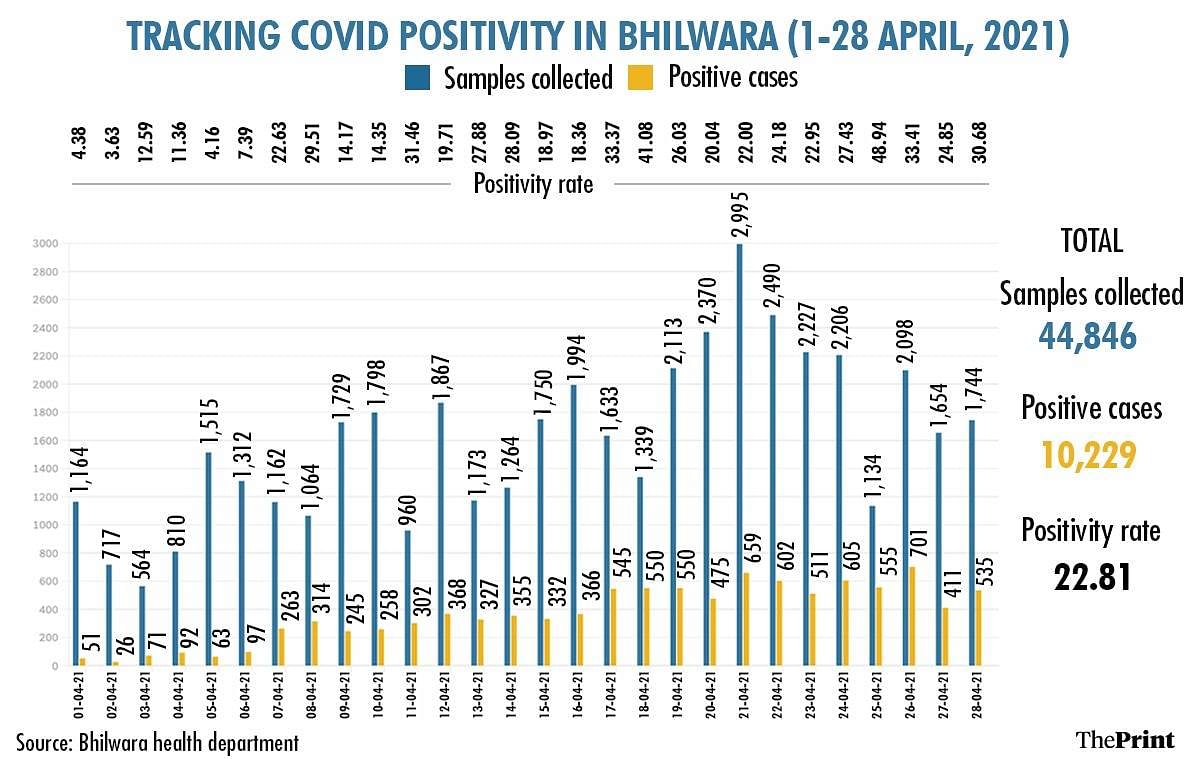
Healthcare workers list Kumbh returnees, festivals such as Holi, Shab-e-Barat and Gangaur, the by-election in the district — held on 17 April — and the return of migrant workers, from places such as Maharashtra and Gujarat, as reasons for the surge.
But while the second wave has dealt the district a heavy blow, Bhilwara is determined to emerge victorious in this battle with the virus.
From maintaining an ‘oxygen audit’ and adding to its oxygen supply, to coordinating between hospitals — government and private — to ensure that patients are allocated beds at the earliest, the district administration is doing its best to ensure that the ‘Bhilwara model’ continues to perform.
“The government staff is working in tandem with the private hospitals here so that we can overcome this together,” said District Collector Shiv Prasad.
The administration has also returned to its earlier mode of ruthless containment and curfews to bring the crisis under control once again.
It is what Rohit Kumar Singh, former additional chief secretary of health and family welfare department, Rajasthan — the Bhilwara model was his brainchild — also suggests. “This wave has come with its own challenges, but perhaps it would help to go back to ruthless containment once again,” he said, adding that it was most important to save lives and prioritise the vulnerable population as they had done last year.
Also read: Modi’s new outdoor meeting trend as latest studies raise concerns on indoor Covid spread
What brought the surge?
Chief district medical officer Mustaq Khan shared that there were 5,429 active cases in the district’s urban areas and 2,512 in rural areas of Bhilwara as of 28 April. Out of the total of 7,941 active cases, 7,071 Covid patients were in home isolation, according to government records.
There are a total of 959 hospital beds across 11 hospitals in the district, of which 868 were occupied Wednesday, said Khan.
While the MG District Hospital is the main Covid treatment facility in the district, two private hospitals have also been taken over by the government and are being managed as government centres. The remaining eight are private facilities.
“Ayush Hospital (with 80 beds) and Ambesh hospital (with 70 beds), have been provided with government infrastructure and staff, but these don’t accept direct admissions. Only those referred by MG District Hospital are taken in here,” Khan told ThePrint.
Authorities during a video conference with state health secretary, Sidharth Mahajan, claimed that Kumbh returnees were adding to the case load in the district, sources told ThePrint.
Sources also told ThePrint that the two Covid deaths in the past one week were those of people who had returned from the Kumbh. The station house officer at the Bhilwara railway station said, “While the train to Rishikesh [in Uttarakhand, where the Kubh Mela was held] starts from Udaipur, at least 250 people were travelling daily by this during March and the first week of April.”
Holi, Shab-e-Barat, and Gangaur festivities, all celebrated in the past one month, also added to the spike, health officials claimed.

Another reason for the spurt in Covid infections, according to them, was the by-elections held in Rajasthan on 17 April. Sahara, in Bhilwara, was among the three assembly seats for which the by-polls were held in the state this month. In fact, even those with Covid-19 were allowed to cast their votes.
According to the state health bulletin, Rajasthan reported 7,359 new cases on 16 April, a day before the elections. The day after the polls, on 18 April, the number of new cases in the state had gone up to 19,515. In Bhilwara, the number of new cases went from 366 on 16 April to 550 on 18 April.
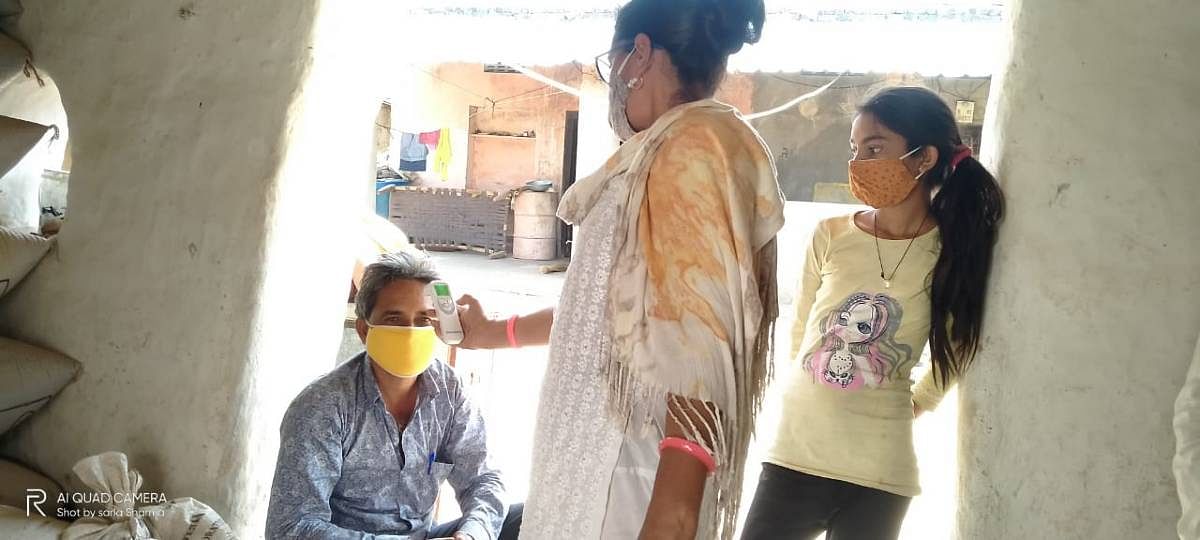
The district is also home to a sizeable migrant population, working in states like Maharashtra and Gujarat. Bhilwara’s Gangapur tehsil is a hub of ice cream vendors working in Maharashtra and Gujarat.
“Many of these vendors came back from Maharashtra when the cases were on the rise there last month, so we feel that has also led to an increase in infection here,” said assistant district magistrate (ADM) Rakesh Kumar. He added that these vendors were moving around across the district, until the curfew came into place earlier this month.
Also read: Tamil Nadu wasted 8.8% of its Covid vaccine doses, UP has the largest stock, govt data says
Oxygen audits and a transition room for patients
Meanwhile, the district authorities are doing their best to revive the old ‘Bhilwara model’ for tackling Covid.
According to state government data, the local administration has been trying to maintain oxygen supply for over 7,000 patients at any given time. While the Mahatma Gandhi Hospital has been running out of beds, hospital authorities have been able to maintain its oxygen supply, assistant district magistrate (ADM) Bhilwara, Rakesh Kumar, who has been overseeing the arrangements in the hospital, told ThePrint
The Bhilwara Collector, Shiv Prasad, said that “while the oxygen plants in the district had the capacity to cater to only 450 patients [when the second surge began], Bhilwara was managing to provide 900 patients hospital beds with oxygen support since 13 April. We have arranged for an additional 1,700 [empty] oxygen cylinders in the district,” which can be refilled.
While the empty cylinders were collected from industrial units, oxygen generation plants, godowns — Bhilwara has also bought empty cylinders from Gujarat in the past few weeks — the district ramped up its oxygen supply by sourcing it additionally from plants in Chittorgarh and Ajmer. They also cut down on wastage, added Prasad.
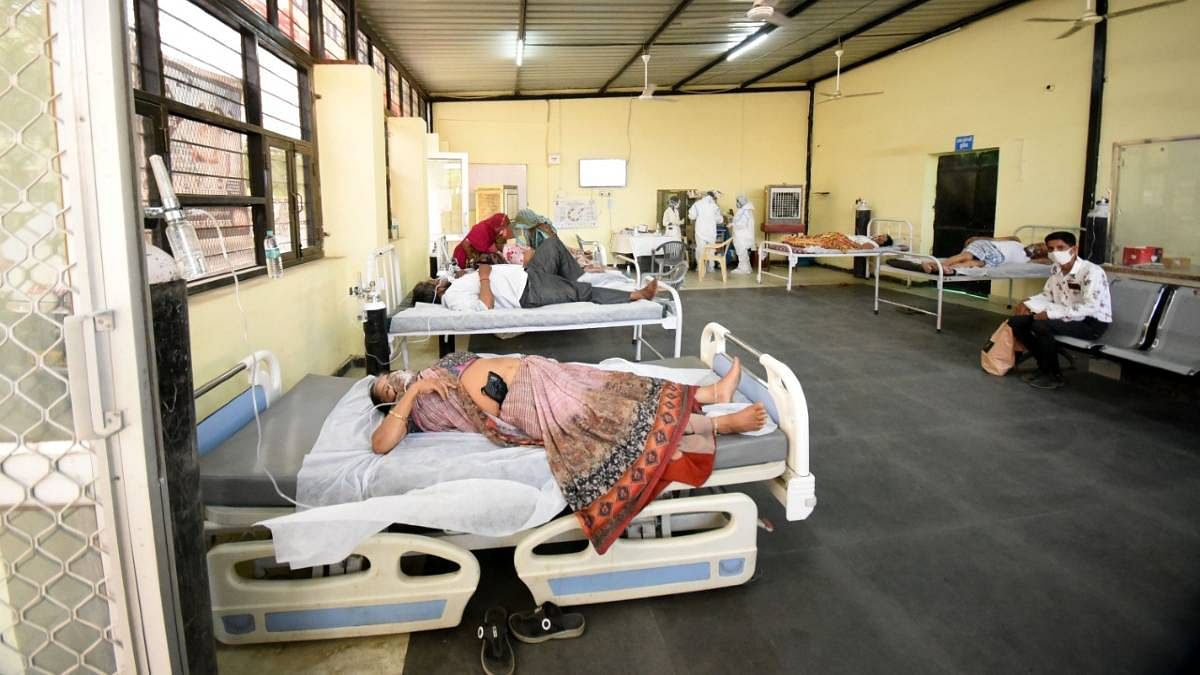
“We were thus able to increase the number of beds with oxygen support in three days, since I was apprehensive that the number of cases would explode after the elections,” he said.
Elaborating on the increased demand for oxygen, Dr Arun Gaur, superintendent, MG District Hospital, said, “This has been the key challenge in the second wave. Even on a bad day, during the first Covid wave, we didn’t require more than 50 cylinders. But now we need at least 400 cylinders every day.”
A visit to Agarwal Bhawan, a banquet hall being used as a storage space for oxygen cylinders in Bhilwara, reveals how the administration has been stocking up on empty oxygen cylinders. These can be refilled with oxygen from the plant located at a distance of about 15 kilometres from the town, so that a seamless cycle of refilling and stocking for emergencies can be maintained.
An “oxygen audit” is being maintained by a committee, as part of which medical technicians in the district are constantly monitoring the supply of oxygen to hospitals, said Kumar.
“We had estimated that we would need to refill at least 1,600 cylinders daily in Bhilwara by the third week of April and hence we had already prepared ourselves on those lines [by ramping up our oxygen supply] by the second week of the month,” Kumar told ThePrint.
The hospital has also created a dedicated space near the hospital’s entrance as a “transition room” for patients. A store room has been converted into a help desk. The transition room has 15 beds with oxygen support for critical Covid patients, who wait for their turn while they’re allocated hospital beds.
The room had 15 patients, monitored by nurses in PPE suits, when ThePrint team visited the hospital Thursday. A screen placed in the room displayed the number of beds available in other private Covid hospitals in Bhilwara.
“The idea is to keep patients informed so that the moment there is a vacancy, we can send them to another hospital, in case we can’t find them a bed at our facility,” said Dr Gaur.
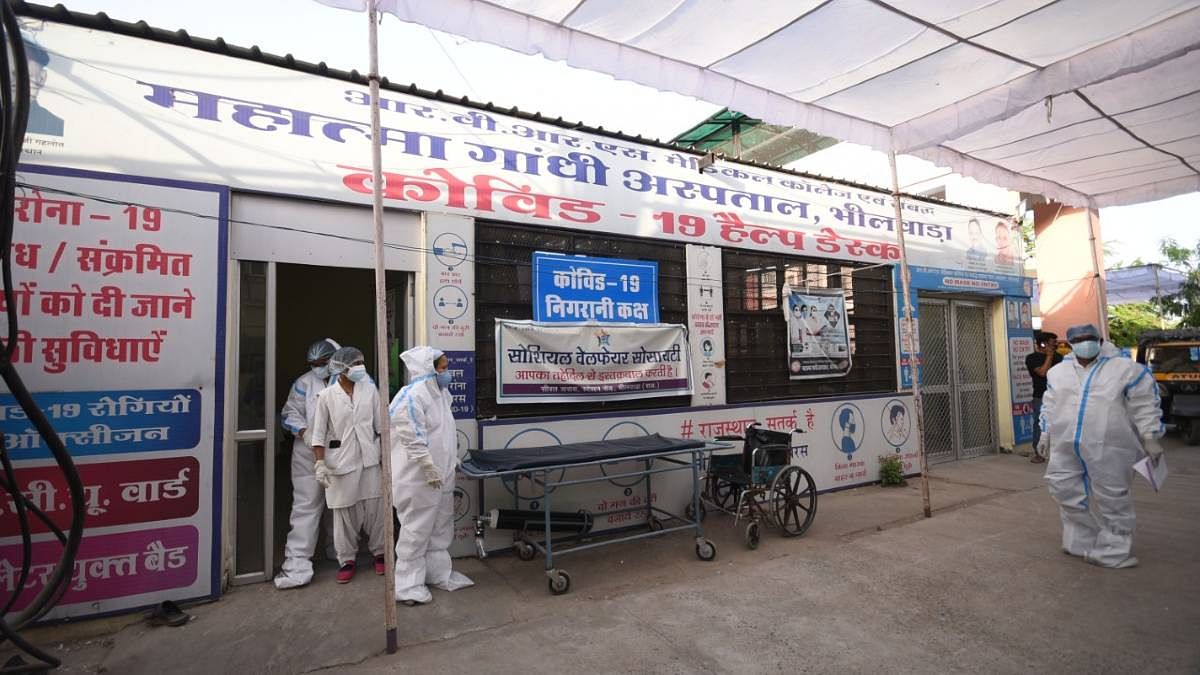
The other thing being stringently followed here is a lockdown on public places.
Even though Rajasthan has extended its initial weekend curfew, imposed on 12 April, into a fortnight-long self-imposed curfew, Bhilwara has taken the idea a step further, to ban even essential workers from stepping out.
“We realised we couldn’t afford any activity and needed people to stay indoors,” added Prasad. In fact, when the first case was reported on 19 March last year, the administration had implemented a curfew, even before the national lockdown was announced.
(Edited by Poulomi Banerjee)
Also read: DD News is Covid ‘positive’. It shows a sanitised version of the pandemic


